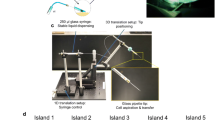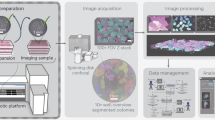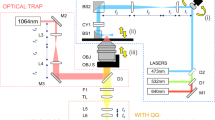Abstract
Recently, biomedical research has moved toward cell culture in three dimensions to better recapitulate native cellular environments. This protocol describes one method for 3D culture, the magnetic levitation method (MLM), in which cells bind with a magnetic nanoparticle assembly overnight to render them magnetic. When resuspended in medium, an external magnetic field levitates and concentrates cells at the air-liquid interface, where they aggregate to form larger 3D cultures. The resulting cultures are dense, can synthesize extracellular matrix (ECM) and can be analyzed similarly to the other culture systems using techniques such as immunohistochemical analysis (IHC), western blotting and other biochemical assays. This protocol details the MLM and other associated techniques (cell culture, imaging and IHC) adapted for the MLM. The MLM requires 45 min of working time over 2 d to create 3D cultures that can be cultured in the long term (>7 d).
This is a preview of subscription content, access via your institution
Access options
Subscribe to this journal
Receive 12 print issues and online access
$259.00 per year
only $21.58 per issue
Buy this article
- Purchase on Springer Link
- Instant access to full article PDF
Prices may be subject to local taxes which are calculated during checkout









Similar content being viewed by others
References
Zhang, S. Beyond the Petri dish. Nat. Biotechnol. 22, 151–152 (2004).
Cukierman, E., Pankov, R., Stevens, D.R. & Yamada, K.M. Taking cell-matrix adhesions to the third dimension. Science 294, 1708–1712 (2001).
Pampaloni, F., Reynaud, E.G. & Stelzer, E.H.K. The third dimension bridges the gap between cell culture and live tissue. Nat. Rev. Mol. Cell Biol. 8, 839–845 (2007).
Atala, A. Engineering tissues, organs and cells. J. Tissue Eng. Regen. Med. 1, 83–96 (2007).
Kleinman, H.K., Philp, D. & Hoffman, M.P. Role of the extracellular matrix in morphogenesis. Curr. Opin. Biotechnol. 14, 526–532 (2003).
Jelovsek, F.R., Mattison, D.R. & Chen, J.J. Prediction of risk for human developmental toxicity: how important are animal studies for hazard identification? Obstet. Gynecol. 74, 624–636 (1989).
Sun, H., Xia, M., Austin, C.P. & Huang, R. Paradigm shift in toxicity testing and modeling. AAPS J. 14, 473–480 (2012).
Bhogal, N. Immunotoxicity and immunogenicity of biopharmaceuticals: design concepts and safety assessment. Curr. Drug Saf. 5, 293–307 (2010).
Perez, R. & Davis, S.C. Relevance of animal models for wound healing. Wounds 20, 3–8 (2008).
Abbott, A. Cell culture: biology's new dimension. Nature 424, 870–872 (2003).
Abbott, A. More than a cosmetic change. Nature 438, 144–146 (2005).
Griffith, L.G. & Swartz, M.A. Capturing complex 3D tissue physiology in vitro. Nat. Rev. Mol. Cell Biol. 7, 211–224 (2006).
Souza, G.R. et al. Three-dimensional tissue culture based on magnetic cell levitation. Nat. Nanotechnol. 5, 291–296 (2010).
Hajitou, A. et al. A hybrid vector for ligand-directed tumor targeting and molecular imaging. Cell 125, 385–398 (2006).
Souza, G.R. et al. Networks of gold nanoparticles and bacteriophage as biological sensors and cell-targeting agents. Proc. Natl. Acad. Sci. USA 103, 1215–1220 (2006).
Souza, G.R. et al. Bottom-up assembly of hydrogels from bacteriophage and Au nanoparticles: the effect of cis- and trans-acting factors. PLoS ONE 3, e2242 (2008).
Tseng, H. et al. Assembly of a three-dimensional multitype bronchiole co-culture model using magnetic levitation. Tissue Eng. Part C Methods 19, 665–675 (2013).
Daquinag, A.C., Souza, G.R. & Kolonin, M.G. Adipose tissue engineering in three-dimensional levitation tissue culture system based on magnetic nanoparticles. Tissue Eng. Part C Methods 19, 336–344 (2013).
Molina, J.R., Hayashi, Y., Stephens, C. & Georgescu, M.-M. Invasive glioblastoma cells acquire stemness and increased Akt activation. Neoplasia 12, 453–463 (2010).
Becker, J.L. & Souza, G.R. Using space-based investigations to inform cancer research on Earth. Nat. Rev. Cancer 13, 315–327 (2013).
Marx, V. Cell culture: a better brew. Nature 496, 253–258 (2013).
Lee, J.S., Morrisett, J.D. & Tung, C.-H. Detection of hydroxyapatite in calcified cardiovascular tissues. Atherosclerosis 224, 340–347 (2012).
Bell, E., Ivarsson, B. & Merrill, C. Production of a tissue-like structure by contraction of collagen lattices by human fibroblasts of different proliferative potential in vitro. Proc. Natl. Acad. Sci. USA 76, 1274–1278 (1979).
Shi, Y. & Vesely, I. Fabrication of mitral valve chordae by directed collagen gel shrinkage. Tissue Eng. 9, 1233–1242 (2003).
Nirmalanandhan, V.S., Duren, A., Hendricks, P., Vielhauer, G. & Sittampalam, G.S. Activity of anticancer agents in a three-dimensional cell culture model. Assay Drug Dev. Technol. 8, 581–590 (2010).
Cuchiara, M.P., Allen, A.C.B., Chen, T.M., Miller, J.S. & West, J.L. Multilayer microfluidic PEGDA hydrogels. Biomaterials 31, 5491–5497 (2010).
Xu, X. & Prestwich, G.D. Inhibition of tumor growth and angiogenesis by a lysophosphatidic acid antagonist in an engineered three-dimensional lung cancer xenograft model. Cancer 116, 1739–1750 (2010).
Hirschhaeuser, F. et al. Multicellular tumor spheroids: an underestimated tool is catching up again. J. Biotechnol. 148, 3–15 (2010).
Bernstein, P. et al. Pellet culture elicits superior chondrogenic redifferentiation than alginate-based systems. Biotechnol. Prog. 25, 1146–1152 (2009).
Wang, Z. et al. Inhibitory effects of a gradient static magnetic field on normal angiogenesis. Bioelectromagnetics 30, 446–453 (2009).
Barzelai, S. et al. Electromagnetic field at 15.95–16 Hz is cardio protective following acute myocardial infarction. Ann. Biomed. Eng. 37, 2093–2104 (2009).
Potenza, L. et al. Effects of a 300-mT static magnetic field on human umbilical vein endothelial cells. Bioelectromagnetics 31, 630–639 (2010).
Acknowledgements
This work was supported by a US National Science Foundation (NSF) Small Business Innovation Research Award Phase I (0945954) and Phase II (1127551) from the NSF IIP Division of Industrial Innovation and Partnerships, and by an award from the State of Texas Emerging Technology Fund.
Author information
Authors and Affiliations
Contributions
W.L.H. and D.M.T. contributed equally to this protocol by running the majority of experiments, gathering the bulk of the data presented in this protocol and preparing the manuscript. J.A.G. both helped in gathering data and images for this protocol. H.T. helped to write the manuscript. T.C.K. and G.R.S. invented and optimized the technique described in this protocol.
Corresponding author
Ethics declarations
Competing interests
The University of Texas M. D. Anderson Cancer Center (UTMDACC) and Rice University, along with their researchers, have filed patents on the technology and intellectual property reported here. If licensing or commercialization occurs, the researchers are entitled to standard royalties. G.R.S. and T.C.K. have equity in Nano3D Biosciences, Inc. UTMDACC and Rice University manage the terms of these arrangements in accordance with their established institutional conflict-of-interest policies.
Supplementary information
Supplementary Figure 1
Magnetic levitation in 24-well plates. First, take a 24-well plate (A) and add 300-400 μL of media with cells to each well (B). Next, cover the plate with a 24-well white lid insert (C,D), 24-well magnetic drive (E,F), and lid (G,H). The plate lid can then be annotated and the plate can be transferred into an incubator (I). (PDF 1821 kb)
Supplementary Figure 2
Imaging magnetically levitated 3D cultures in a 96-well plate. First, bring the plate into a sterile environment (A), and remove the lid (B), then magnet (lid insert if necessary) (C). Next, replace the lid atop the 96-well plate (D) and move the plate out of the sterile environment (E) onto a microscope stage to image (F). (PDF 1491 kb)
Supplementary Figure 3
Transferring magnetically levitated 3D cultures from a well plate to a coverslip for imaging. Take a coverslip and place atop the 96-well magnetic drive with the magnets facing upwards (A,B). Next, pick up a 3D culture from a well plate with a Teflon pen (C). With the culture attached to the pen (D), remove the magnet from the pen (E). The 3D culture should still stay on the pen (F). Finally, place the culture on the coverslip by moving it close to the magnetic drive over the coverslip (G). (PDF 3614 kb)
Rights and permissions
About this article
Cite this article
Haisler, W., Timm, D., Gage, J. et al. Three-dimensional cell culturing by magnetic levitation. Nat Protoc 8, 1940–1949 (2013). https://doi.org/10.1038/nprot.2013.125
Published:
Issue Date:
DOI: https://doi.org/10.1038/nprot.2013.125
This article is cited by
-
Emerging 3D bioprinting applications in plastic surgery
Biomaterials Research (2023)
-
Spatially controlled construction of assembloids using bioprinting
Nature Communications (2023)
-
Acoustic and Magnetic Stimuli-Based Three-Dimensional Cell Culture Platform for Tissue Engineering
Tissue Engineering and Regenerative Medicine (2023)
-
Progress in bioprinting technology for tissue regeneration
Journal of Artificial Organs (2023)
-
Bioengineering in salivary gland regeneration
Journal of Biomedical Science (2022)
Comments
By submitting a comment you agree to abide by our Terms and Community Guidelines. If you find something abusive or that does not comply with our terms or guidelines please flag it as inappropriate.



